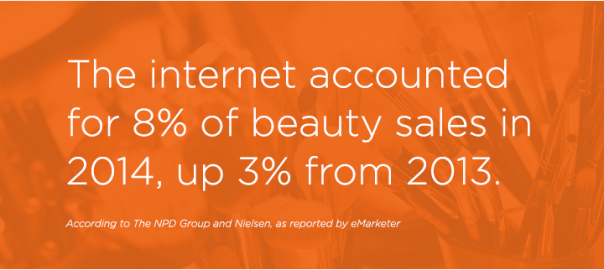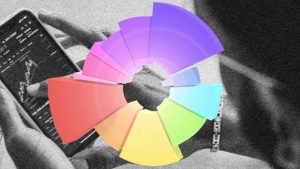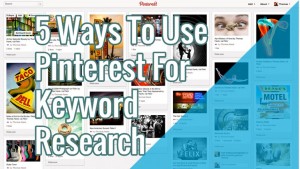Though in-store sales still comprise the bulk of consumer spending, the prevalence of ecommerce has made it almost too easy to purchase food, clothing, electronics and, well, almost anything online. Yet while many industries are thriving, the beauty sector has had a more difficult time finding success in the ecommerce environment.
Why? For starters, sales of products like lipstick, blush, nail polish and eyeshadow are often contingent on a precise color harmonizing with a particular skin tone or style. Stock photos, in which colors tend to get skewed during the photo editing and upload process, don’t make things any easier. For a long time, consumers understood that unless they had used a certain product in the past, buying makeup online could be a tricky bet.
But the tides are changing.
Research from The NPD Group and Nielsen (as reported by eMarketer) shows that the internet accounted for 8% of beauty sales in 2014, a 3% increase from 2013. We can probably attribute this to the pervasiveness of mobile devices, the popularity of photo-sharing platforms, and the growth of a style of image that speaks to beauty loving fans. These days, everyone is a content creator, and makeup fans are particularly tuned into the dynamic, having created a highly active online community. In fact, makeup influencers such as Jaclyn Hill and Manny Gutierrez have more followers on social networks than some leading actors and chart-topping singers.
The end result is that these days, it’s not that difficult for a consumer to visualize what a makeup product will look like in the real world. Consumers genuinely enjoy sharing their experiences. Some beauty brands are leveraging their fans’ eagerness to share content, and calling on influencers and fans to share photos for distribution on various channels. Other brands are adopting techniques they’ve seen from consumers, and creating authentic, editorial-style images themselves. Here are three who are doing it well.
1. Sephora: Showing Consumers How It’s Done

One of the biggest pain points for online makeup shoppers is that they have no idea how a particular shade will look on them. Consumers often want to adopt trends they see online, but have a difficult time figuring out if they can pull it off in life. Sephora relies on a mix of user-generated and branded content—both of which have a very approachable, human feel—to help their consumers in this area. For example, the brand recently used a Layout-style Instagram post to depict four different consumers wearing berry-colored lipstick, showing how people with varying looks can tap into the trend. The post was well received and prompted consumers to ask for additional details on the colors featured.
The brand could leverage this further by sending consumers emails about trends, and featuring this same authentic-style imagery within them. Delivering helpful and engaging content like this straight to a consumer’s inbox will very likely result in a win-win.
2. Ulta: Branded Editorial Content Makes Waves

Ulta’s Instagram feed is reminiscent of a beauty magazine, and in the most favorable way possible. Whether the content originates from the brand or from an influencer, everything looks authentic and engaging.
Before-and-after photos, for example, have long been popular among consumers who read magazines and beauty articles online. The brand uses that to its advantage by sharing before-and-after shots that show how a consumer can achieve a desired look. These photos, which are often featured on Instagram, include a how-to description in the caption, and followers respond really well.
The brand also features a similar style of image directly within product detail pages on Ulta.com. This helps to show consumers who might still be on the fence what they’ll achieve by buying a product – and at a critical point in the shopping process.
3. Sigma Beauty: Content from Influencers Sells

International cosmetics brand Sigma Beauty is the perfect example of a brand benefitting from the prevalence of online photo sharing. Sigma Beauty has just one brick-and-mortar store, making the brand heavily reliant on ecommerce to drive revenue. By tapping YouTube influencers early on in its business, the brand made a huge name for itself in the beauty space.
Today, the brand does more than just partner with influencers on YouTube and Instagram. On its site, the brand includes UGC alongside each product for sale. Consumers respond really well to this. Sigma Beauty is reporting a nearly 4x lift in time-on-site since adding UGC to its ecommerce site.
(127)









